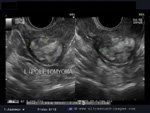Lipoleiomyoma of Uterus
The fibroid is a tumor that is very frequently encountered in the uterus on both clinical examinations as well as on routine pelvic sonography.
The fibroid is a tumor that is very frequently encountered in the uterus on both clinical examinations as well as on routine pelvic sonography. One of the rarer and less well known uterine masses is the lipoleiomyoma. Like the leiomyoma of the uterus, the lipoleiomyoma is also a benign, well defined mass but has a very high content of fatty or adipose tissue.
What is the pathology?
The lipoleiomyoma is a benign uterine mass containing adipose cells, hyperplastic smooth muscle and fibrous tissue.
What is the etiology?
It is believed that lipoleiomyomas of the uterus are the result of fatty degeneration or metamorphosis of uterine smooth muscle cells within a fibroid or leiomyoma.
What are the presenting symptoms and how is the patient diagnosed?
The patient usually presents with symptoms that mimic those of uterine fibroids- namely pelvic discomfort, irregular menses and lower abdominal pain. Other patients often present with hypermenorrhoea. This patient, presented with lower abdominal pain and hypermeorrhoea. (ultrasound images below). Most cases of lipoleiomyoma are diagnosed in women with a history of pre-existing fibroids of the uterus.
Sonographic Image Findings
Sagittal section of uterus:

Transverse section of uterus:

Images courtesy of Dr. Jaydeep Gandhi, MD, India
These sections of the uterus show an echogenic, well defined lobulated mass in a posterior location in the body of the uterus. It is typically intramural in location as seen in the images above; however it can be submucosal or subserosal in location. In addition, note the presence of a sonographic halo around the mass, typically seen in lipoleiomyomas. This halo represents compressed myometrial tissue around the margins of the tumor. Image-1 also shows a small amount of fluid in the uterine cavity, an incidental finding. CT scan imaging further confirmed the presence of fatty tissue within this mass. CT imaging is very sensitive and specific for the diagnosis of lipoleiomyoma of the uterus and shows fatty tissue with interspersed non fatty tissue within the uterine mass. MR imaging showed high signal intensity on T1 weighted images. Fat suppression MR imaging also helped visualize the presence of fatty tissue within the mass.
What are the differential diagnosis?
1) Ovarian cystic teratomas can also present a similar appearance on transabdominal ultrasound imaging. However, transvaginal imaging helps differentiate the location of the ovarian mass from uterine location in lipoleiomyoma of the uterus. The real diagnostic dilemma occurs when the mass in question is rather large in size making identification of the organ of origin difficult. In very rare cases lipoleiomyomas have been reported in ovarian location.
2) Fibromyolipoma of the uterus may also produce similar appearances but this is mainly a pathological diagnosis. This tumor would have lower fat content compared to lipoleiomyomas. Liposarcomas and benign pelvic lipomas may also produce similar imaging findings.In the case of a very large lipoleiomyoma (or for that matter any huge pelvic mass), it may not be possible to identify the organ/ site of origin of the mass (ie: whether the tumor originates from the uterus or ovary) on abdominal or transvaginal ultrasound. Here, again CT and MR imaging may be very useful in ascertaining the site of origin of the mass and its internal characteristics.
What is the prognosis?
Generally, small asymptomatic lipoleiomyomas do not require surgical management. Surgery is useful and indicated in larger masses and in the presence of menstrual complaints. In the case shown above the mass was 2.8 x 3 cms. This patient was advised to undergo follow up ultrasound studie's to look for changes in the tumor size and its characteristics.
Add your comments below! Would you like to submit your blog? Let us know!
References:
References:
1)Avritscher R., Iyer R. B, Ro J., Whitman G. Lipoleiomyoma of the Uterus. American Roentgen Ray Society. 177, October 2001 http://www.ajronline.org/content/177/4/856.full.pdf Accessed December 2011
2) Chawla A, Rathod K., Raut A., Garg A, Thakker A., Telkar H, Kamat N. Uterine lipoleiomyoma Applied Radiology. Vol. 33, Number 4, April 2004 http://www.appliedradiology.com/Issues/2004/04/Articles/Uterine-lipoleiomyoma.aspx Accessed December 2011
3) Tsushiam Y., Kita T., Yamamoto K. Uterine lipoleiomyoma: MRI, CT and ultrasonic findings. British Journanl of Radiology. 70 (1997) http://bjr.birjournals.org/content/70/838/1068.full.pdf Accessed December 2011
4)Antony J. Ultrasound image gallery. lipoleiomyoma
S1E4: Dr. Kristina Adams-Waldorf: Pandemics, pathogens and perseverance
July 16th 2020This episode of Pap Talk by Contemporary OB/GYN features an interview with Dr. Kristina Adams-Waldorf, Professor in the Department of Obstetrics and Gynecology and Adjunct Professor in Global Health at the University of Washington (UW) School of Medicine in Seattle.
Listen
Study shows a healthy prenatal diet could be upstream obesity prevention strategy
December 26th 2024"Our findings support the recommendation of a healthy diet based on the current guidelines (as measured by the HEI) during pregnancy, since it may reduce patterns of infant growth outside reference ranges."
Read More
Early pregnancy cannabis use high in states with recreational legalization
November 11th 2024A population-based time-series analysis California before, during and after legalization show a rising trend in women using cannabis while pregnancy especially when the state has legalized the drug.
Read More
